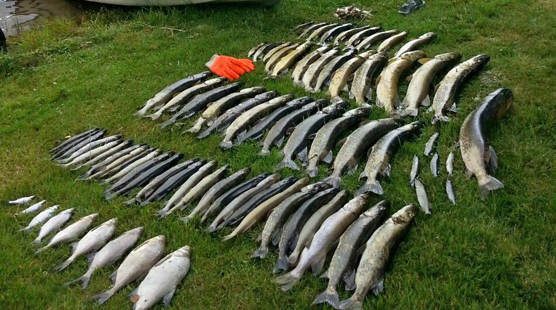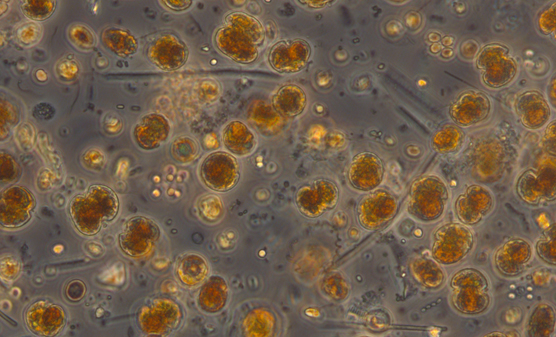Press release 2016-02-24 at 17:04
Scientists at SYKE Marine Research Centre have related the fish kill in Ersöströmmen near Tammisaari last July to a dinoflagellate species, Karlodinium veneficum, not previously known to form blooms in Finnish waters.

Fish kill at Ersöströmmen in July 2015. © Simon Lundström
Water samples taken at the time of the fish kill in Ersöströmmen had a brown color, which according to microscopic analysis conducted at SYKE MRC was due to unusually high concentrations (over 10 million cells/L) of a small dinoflagellate of ca. 10 µm in size.
“Later DNA analyses confirmed the species to be Karlodinium veneficum. This dinoflagellate produces highly potent karlotoxins, which have lytic effects on different types of cells. In fish, karlotoxins specifically target the gill cells leading to suffocation”, says senior research scientist Anke Kremp from the SYKE MRC.
Karlodinium veneficum blooms have caused massive fish-kills all over the world, particularly in shallow coastal waters and low salinity river estuaries. Bloom formation is boosted by the ability of this species to supplement nutrition by feeding on other phytoplankton, which are killed with the help of karlotoxins. Thus, eutrophic conditions, favoring the growth of phytoplankton prey are considered a primary prerequisite for toxic Karlodinium blooms.

Karlodinium cells in a water sample collected from the site of the Fish kill. © Sirpa Lehtinen, SYKE
Though records of the species from different areas of the Baltic Sea exist, it has so far not raised much attention as a bloom former. Apart from an incidence at the Swedish South coast that was suspected, but not confirmed, to be caused by K. veneficum, the Ersöströmmen fish kill is the first in the Baltic Sea shown to be related to this species. There seems to be a generally increased risk of fish killing algal blooms in coastal Baltic waters, a trend that likely results from high water temperatures in summer. Globally, significant Karlodinium blooms are associated with water temperatures above 20 C. Though not directly harmful to humans, the blooms may cause considerable losses to aquaculture and fisheries.
A novel algal toxin found from Åland
Previously, another toxic dinoflagellate species, bioluminescent Alexandrium ostenfeldii, has raised the attention of scientists because it has started to form recurrent neurotoxic blooms during warm summers in coastal waters all around the Baltic Sea. The species produces saxitoxin which can cause paralytic shellfish poisoning in humans when contaminated seafood is consumed. Besides saxitoxins, the species can produce another group of neurotoxins, cyclic imines.
A new cyclic imine, gymnodimine D, was isolated and characterized recently from Finnish Alexandrium material by collaborative efforts of MRC and University of Helsinki scientists. Gymnodimines are only produced by two species of marine dinoflagellates. The toxin has been found to be highly concentrated in water samples originating from Åland.
“Worldwide, three other types of gymnodimines are known. Generally the environmental impacts of these toxins are still largely unknown since blooms of gymnodimine producing dinoflagellates with a potential for significant toxin accumulation have so far occurred rarely”, Kremp says.
Toxic dinoflagellates are expanding
The recent expansion of gymnodimine producing dinoflagellates in brackish-water areas around the world with new toxic bloom events being reported, apart from the Baltic, e.g. from the Netherlands, USA and Japan, has increased the concern about the potential harmful impacts of gymnodimines and they are now considered emerging toxins which need to be studied more extensively. The compounds are known to accumulate in shellfish.
Human intoxications caused by gymnodimines have not been reported yet, and since their toxicity to humans is still uncertain, they are not regulated or monitored presently in seafood. However, this may have to change, given the increasing amounts of gymnodimines in the environment.
The expansion of gymnodimine producing dinoflagellate blooms also seems to be connected to a general warming of the water, leading to higher water temperatures and longer warm water periods in summer.
More information:
Dr. Anke Kremp, Doc., Senior Research Scientist
Finnish Environment Institute SYKE, Marine Research Center
firstname.lastname@ymparisto.fi
Tel. +358 40 1823 245
Dr. Sanna Suikkanen, Doc., Senior Research Scientist,
Finnish Environment Institute SYKE, Marine Research Center
firstname.lastname@ymparisto.fi
Tel. +358 295 251 660